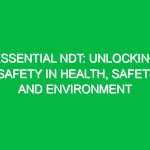Introduction
In the realm of Health, Safety, and Environment (HSE), the term “chemical hazard” refers to any chemical that poses a risk to the health and Safety of individuals or the environment. Understanding how to define chemical Hazards is crucial for organizations aiming to mitigate risks associated with hazardous substances. The implications of chemical Hazards extend beyond immediate Safety concerns; they also encompass regulatory compliance, environmental protection, and overall Workplace Safety culture. This article explores the significance of defining chemical hazards and provides comprehensive insights into their identification, management, and regulatory considerations within the HSE context.
The Importance of Defining Chemical Hazards
Defining chemical hazards is a foundational aspect of risk assessment and management in HSE. When organizations accurately identify and categorize chemical hazards, they can implement appropriate Safety Measures, ensure regulatory compliance, and ultimately protect employees, communities, and the environment. For instance, in a manufacturing plant, the presence of volatile organic compounds (VOCs) might pose a significant health risk if not properly managed.
Moreover, understanding chemical hazards allows companies to foster a culture of safety. Employees who are educated about the risks associated with the chemicals they handle can make informed decisions, report unsafe conditions, and follow Best Practices in their work environments. This proactive approach not only enhances safety but also leads to increased productivity and morale.
Key Aspects of Defining Chemical Hazards
To effectively define chemical hazards, one must consider several key aspects:
1. Types of Chemical Hazards
Chemical hazards can be classified into several categories, including:
- Physical Hazards: These include flammable, explosive, and reactive substances that can cause physical harm.
- Health Hazards: Chemicals that can cause health issues, such as carcinogens, teratogens, and irritants.
- Environmental Hazards: Substances that can harm the environment through pollution or degradation of ecosystems.
Understanding these categories is vital for proper risk assessment and Control Measures.
2. Risk Assessment Procedures
Defining chemical hazards involves a systematic approach to risk assessment. This process typically includes:
- Identification: Recognizing the chemicals present in the workplace and their potential hazards.
- Evaluation: Assessing the risks associated with these chemicals, considering factors such as exposure levels and toxicity.
- Control Measures: Implementing strategies to mitigate identified risks, such as engineering controls, personal protective equipment (PPE), and administrative policies.
For example, in a laboratory setting, the presence of a highly toxic chemical would necessitate stringent controls, including proper ventilation, PPE, and strict adherence to safety protocols.
3. Safety Data Sheets (SDS)
Safety Data Sheets are essential documents that provide detailed information about a chemical’s properties, hazards, handling, and emergency measures. These sheets are a critical resource for employers and employees alike in understanding and defining chemical hazards. Each SDS typically includes:
- Identification: Product name, supplier details, and recommended uses.
- Hazard Identification: Classification of hazards and warning labels.
- First-Aid Measures: Steps to take in case of exposure or accidents.
- Exposure Controls: Recommendations for PPE and exposure limits.
Employers should ensure that an up-to-date SDS is readily available for all chemicals used in the workplace.
4. Training and Awareness
Proper Training is essential for employees to recognize and manage chemical hazards effectively. Organizations should implement comprehensive training programs that cover:
- The nature of chemical hazards present in the workplace.
- Safe handling and storage practices.
- Emergency response procedures in case of exposure or spills.
For instance, a manufacturing facility might conduct regular training sessions to keep employees informed about new chemicals introduced to the production line and their associated risks.
Potential Hazards and Safety Considerations
Recognizing potential hazards associated with chemical substances is a critical component of defining chemical hazards. Some common hazards include:
- Corrosive Chemicals: Substances that can damage skin or corrode materials, such as acids and alkalis.
- Carcinogens: Chemicals that are known to cause cancer, requiring stringent controls and monitoring.
- Reproductive Toxins: Substances that can affect reproductive health, necessitating special Precautions for pregnant workers.
Organizations must adopt a multi-faceted approach to safety, addressing these hazards through appropriate engineering controls, administrative practices, and PPE.
Regulations and Standards Governing Chemical Hazards
Various Regulations and standards govern the management of chemical hazards in the workplace. Some of the most significant include:
1. Occupational Safety and Health Administration (OSHA)
In the United States, osha sets forth regulations regarding hazardous chemicals in the workplace. The Hazard Communication Standard (HCS) requires employers to inform and train employees about chemical hazards they may encounter. This includes labeling requirements and the provision of SDS.
2. European Union REACH Regulation
The REACH (Registration, Evaluation, Authorisation, and Restriction of Chemicals) regulation requires companies to register chemicals and assess their risks. This ensures that chemical hazards are identified and managed throughout their lifecycle.
3. Environmental Protection Agency (EPA)
The EPA oversees regulations regarding the environmental impacts of chemical hazards. The Resource Conservation and Recovery Act (RCRA) governs the disposal of hazardous waste, while the Clean Air Act regulates emissions of hazardous air pollutants.
Compliance with these regulations not only helps organizations avoid legal repercussions but also enhances their reputation as responsible corporate citizens.
Conclusion
Defining chemical hazards is a crucial component of health, safety, and environmental management. By accurately identifying and categorizing chemical hazards, organizations can implement effective risk management strategies that protect employees, the public, and the environment. This proactive approach fosters a culture of safety, ensuring that workers are educated and equipped to handle hazardous substances responsibly.
As the landscape of chemical usage evolves, ongoing education, training, and compliance with regulatory standards will be vital in managing chemical hazards effectively. Organizations must remain vigilant, continually assessing and adapting their strategies to safeguard health and safety in the workplace. By doing so, they contribute not only to the well-being of their employees but also to the Sustainability of the environment.


